WEEKLY HIGHLIGHTS FOR 18 JUNE 2004:
GRAVITY PROBE B MISSION UPDATE
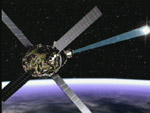
Just under two months into the mission, the spacecraft is in good health, and all subsystems are performing well. The spacecraft’s orbit continues to be stable, meeting our requirements for transition into the science phase of the mission. All four gyros remain digitally suspended, and we are completing the planned series of calibration tests at very low gyro spin rates. The science telescope remains locked onto the guide star, IM Pegasi, and we are beginning the process of distributing and balancing the mass of the spacecraft at increased roll rates, as required for the science mission. For reasons discussed below, the Initialization and Orbit Checkout (IOC) phase of the mission has been extended to 90 days.
- Last Saturday, the team was honored to have NASA Administrator Sean O’Keefe,
Alaska Senator Ted Stevens, and some of their staff members visit the GP-B
facilities here at Stanford University. The visit began with brief presentations
by GP-B NASA Program Manager, Rex Geveden from Marshall Space Flight Center,
Principal Investigator Francis Everitt, and Stanford Program Manager Gaylord
Green. Next, the group viewed a display of spare flight gyroscopes, the flight
telescope, and other hardware and then toured the Mission Operations Center
(MOC), talking with members of the GP-B Operations team who were on duty
and observing them in action. While the visitors were watching, the MOC received
data relayed from the spacecraft through the Tracking Data Relay Satellite
System (TDRSS) to the ground tracking station at White Sands, New Mexico,
as the guide star returned to view in the telescope during a validation check.
- This past week, the team increased the roll rate of the spacecraft from 0.1 rpm to 0.3 rpm, in preparation for “mass trim” and “bubble wrap.” These procedures are used to bring the entire spacecraft into balance so that it rolls smoothly about its main axis, while continuing to focus on the guide star through the telescope. The mass trim operation is similar to dynamically spin balancing a tire, using movable weights on the spacecraft frame under computer control to adjust the spacecraft’s center of mass. Bubble wrap is the process of uniformly distributing the liquid helium around the Dewar’s outer shell. We will accomplish this by increasing the roll rate of the spacecraft in steps, from 0.3 rpm to 0.6 rpm.
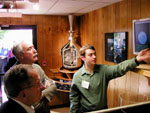
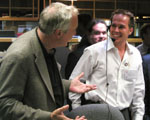
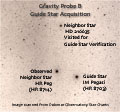
- Also during this past week, the spacecraft/telescope re-visited guide star neighbor HD 216635 (SAO 108242) as well as guide star neighbor HR Peg (HR 8714), for further testing and brightness calibration.
- Another important event this past week was using the results of prior gyro
calibration tests to fine-tune the Gyro Suspension System (GSS) for each
gyro. This significantly improved the suspension performance of all the gyros,
especially gyro #2. Parameters are now in place for spinning up the gyros
to 5 Hz (300 rpm).
- We have received several email inquiries about how the spin rate of the gyroscopes is determined in orbit. It is determined using the SQUIDs. Even though the gyros are currently spinning very slowly, there is enough trapped magnetic flux on the gyro rotors for the SQUIDs to detect their rotation speed to an accuracy of 10 millionths of a Hertz. Because the measurement is made between the gyro rotors and their housings, and because the gyro housings are connected to the spacecraft itself, the roll rate of the spacecraft was also measured using the gyros. In fact, two of the gyros spin in the same direction as the spacecraft roll, and two spin against the roll. Thus, as the roll rate of the spacecraft was increased, two of the gyros appeared to spin faster, and two appeared to slow down in accordance with the increased roll rate.
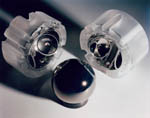
- As chronicled in previous weekly updates, two difficulties--now both overcome--have made the task of locking onto the guide star take longer than anticipated, and as a result, the IOC phase of the mission has been extended from 60 to 90 days. First, the side-facing star trackers on the spacecraft required an extended search period to properly identify the known field of stars. Feedback from these star trackers is used to orient the spacecraft in the vicinity of the guide star, similar to using a spotting telescope to position a high-powered telescope on a particular part of the sky. The second is from malfunction of two of the spacecraft’s 16 ultra-sensitive micro thrusters. Redundancy built into the system enables the spacecraft to fly without the two problematic thrusters, but to optimize performance with 14 instead of 16 thrusters, it was necessary to revise the control software. This software change has now been implemented, and after a Flight Readiness Review on June 25, 2004, it will be uploaded to the spacecraft. At a later stage, we will explore partial re-activation of the two problematic thrusters.
The spacecraft is being controlled from the Gravity Probe B Mission Operations Center, located here at Stanford University. The Stanford-NASA/MSFC-Lockheed Martin operations team is continuing to perform superbly.
Please Note: During the Initialization & Orbit Checkout (IOC) Phase of the GP-B mission, we will update this Web site and send out an email update once a week (usually on Thursday or Friday) to keep you apprised of our progress. From time to time, we may post and email extra updates, as warranted by mission events.
Images & Photos: The drawing of the GP-B spacecraft in orbit, was extracted from an animation created by Adam Jeziak and Aaron Pozzer. This animation is part of a 26-minute movie about GP-B, entitled Testing Einstein's Universe (see description below). The first photo shows NASA Administrator Sean O'Keefe having a lively discussion with GP-B staff member Brad Jones. In the second photo, GP-B graduate student Brandon Owens is demonstrating the spacecraft-on-orbit simulation software he created to NASA Administrator O'Keefe and Senator Stevens. These photos were taken by GP-B Public Affairs Coordinator Bob Kahn. The photo of the star field containing IM Pegasi and its neighbors was scanned from a Palomar Observatory Sky Chart. Finally, the photo of the GP-B gyroscope rotor (sphere) and housings was taken by photographer Don Harlan. Click on the thumbnails to view enlarged copies of these images.
LEARN MORE ABOUT THE GP-B GUIDE STAR, IM PEGASI
For an overview about why we chose IM Pegasi as our guide star, and its importance to the GP-B mission, see our Guide Star FAQ. Also, pages 18-20 of the Gravity Probe B Launch Companion contain information about the guide star and the science telescope.
Furthermore, the ETH Institute of Astronomy in Zurich, Switzerland, is working with the Harvard-Smithsonian Center for Astrophysics to provide detailed optical information about the GP-B guide star, IM Pegasi. You can find out about the ETH Institute's work in monitoring magnetic activity on IM Pegasi and the Doppler Imaging Technique used for this purpose on the ETH Institute of Astronomy GP-B Web page.
Some readers have asked for alternative names for IM Pegasi as might be found in different stellar catalogs and charts. Those include: IM Peg, HR 8703, HD 216489, SAO 108231, BD +16 4831, FK5: 3829
TRACKING THE GP-B SPACECRAFT
Find the Gravity Probe B satellite in the sky at NASA's satellite tracking web site. See where GP-B is with respect to the terminator (the day-night boundary on the Earth's surface), or just enter your zip code to see if GP-B might be over your neighborhood. The best time to look for it is usually at dusk.
Also, you can track the GP-B spacecraft on your Palm OS or Pocket PC Personal Digital Assistant (PDA), using either PocketSat or PocketSat+ from Big Fat Tail Productions. Both products are PDA Shareware, so you can try them out for free. If you decide to use them, Big Fat Tail asks that you pay a nominal shareware fee.
FOLLOW IOC ACTIVITIES AND LEARN MORE ABOUT GRAVITY PROBE B
If you are interested in following the IOC procedures more closely, you'll find a schedule and description of them on pages 12-14 of the Gravity Probe B Launch Companion. This document also provides an overview and explanation of the Gravity Probe B experiment and information about the spacecraft and GP-B's amazing technologies. Click here to download the GP-B Launch Companion in Adobe Acrobat PDF format. (Please note: this file is 1.6 MB, so it may take awhile to download if you have a slow Internet connection.)
Norbert Bartel, Professor of Astrophysics and Space Sciences at York University in Toronto, Canada, has produced and directed a 26-minute documentary movie about the Gravity Probe B experiment entitled, Testing Einstein's Universe. This movie, along with 80 minutes of additional video about relativity, physics, and astronomy is available on a DVD, which you can purchase from the Website: http://www.astronomyfilms.com/
VIEW A VIDEO OF THE GP-B LAUNCH
 Click
here to view a 3 1/2 minute QuickTime video clip of the GP-B launch, produced
by the Stanford News Service. Please note that the video requires Quick Time to play.
Click here to
link to
download Quick Time.
Click
here to view a 3 1/2 minute QuickTime video clip of the GP-B launch, produced
by the Stanford News Service. Please note that the video requires Quick Time to play.
Click here to
link to
download Quick Time.![]()
FOLLOWING THE GP-B MISSION ON THE WEB
In addition to this Web site, here are some other Web sites that have information, photos, and video of the GP-B launch and mission.
- The ELV Missions Virtual Launch Center Web page on the John F. Kennedy Space Center Web site has information and several streaming video clips covering the GP-B mission. (You can view these video clips free of charge, but you will need to have either the Real Media Player or Windows Media Player installed on your computer to view them.)
- NASA's Marshall Space Flight Center Gravity Probe B.com Web page has a number of great photos from the GP-B launch, including photos of the spacecraft separation, as well as other information about Gravity Probe B.
- The Science @ NASA Web site, hosted by NASA's Marshall Space Flight Center, posts several stories each month about scientific research projects in which NASA is involved. This site currently features two general interest stories about Gravity Probe B: In search of Gravitomagnetism and A Pocket of Near Perfection. (In addition to the Web versions, these stories are also available in both plain text and streaming audio formats.)
- Photographer William G. Hartenstein's Web site has an extraordinary set of photos that he took on launch day.
- Another very comprehensive source of information about the GP-B launch is the Spaceflight Now Web site. This site contains an excellent photo gallery, as well as a number of Quicktime video clips of the launch. However, you have to become a subscriber to this site ($$$) in order to view the video clips.
GRAVITY PROBE B IN THE NEWS
Sunday evening, April 18th, a feature story about Gravity Probe B and principal investigator, Francis Everitt, aired on ABC World News Tonight. Click here to read a text version of the ABC News story. Also on April 18th, NPR's David Kestenbaum talked with GP-B's principal investigator, Francis Everitt on the program All Things Considered. On Friday, April 16th, Gravity Probe B Co-Principal Investigator, John Turneaure, was interviewed by Ira Flatow on NPR Talk of the Nation—Science Friday.
On Tuesday, April 13,2004, Gravity Probe B was the lead story in the Science section of the New York Times, and it was one of the front page stories in the San Jose Mercury News. (You'll need to register on the Web sites of these newspapers to view these stories online.) In addition, a story about GP-B appeared on the New Scientist Web on April 13, 2004.
The official pre-launch Gravity Probe B mission and science briefing was held on Friday, April 2, 2004 at 1:00 PM Eastern Daylight Time at NASA Headquarters in Washington, D.C. The participants in the briefing (pictured from left to right in the photo) were:

- Anne Kinney, Director of Astronomy/Physics Division, NASA Headquarters
- Rex Geveden, Program Manager, GP-B and Deputy Director, NASA's Marshall Space Flight Center in Huntsville, Alabama.
- Francis Everitt, GP-B Principal Investigator at Stanford University, Stanford, California
- Bradford Parkinson, GP-B Co-Principal Investigator at Stanford University, Stanford California
- Kip Thorne, Feynman Professor of Theoretical Physics, California Institute of Technology, Pasadena, California
You can view a Real Player streaming video of this briefing on the Kennedy Space Center GP-B Web site.
RECEIVE GRAVITY PROBE B WEEKLY HIGHLIGHTS BY EMAIL
If you are interested in automatically receiving these weekly highlights and other important GP-B mission information by email, you can subscribe to our Gravity Probe B Update email list by sending an email message to "majordomo@lists.Stanford.edu" with the command "subscribe gpb-update" in the body of the message (not in the Subject line). You can unsubscribe from this mailing list at any time by sending an email message to the same address with the command, "unsubscribe gpb-update" in the body of the message.
Previous Highlight
Index of Highlights
